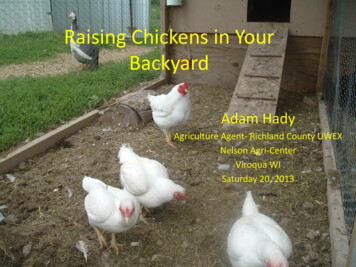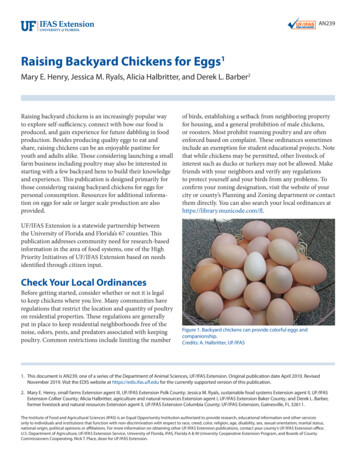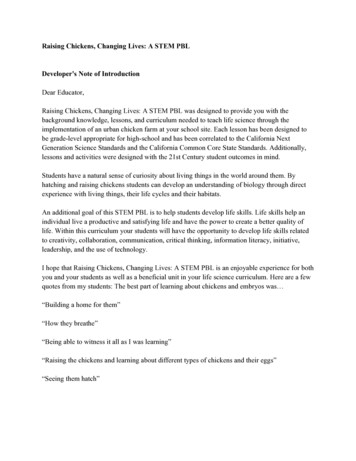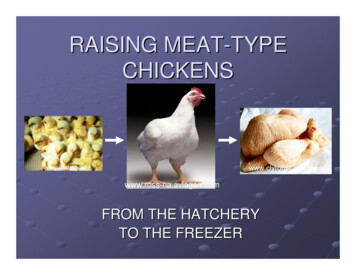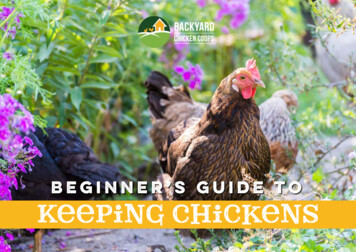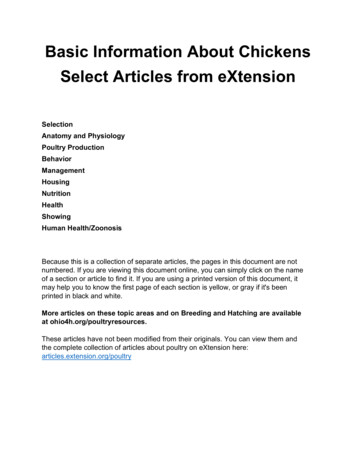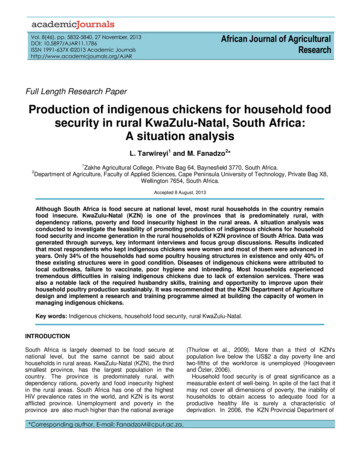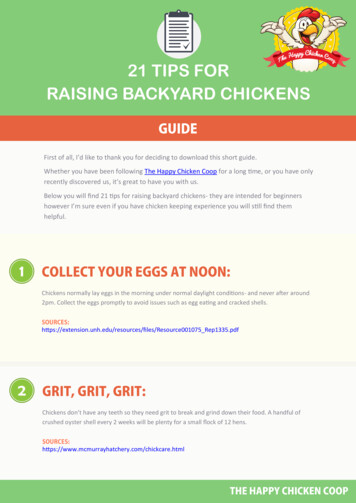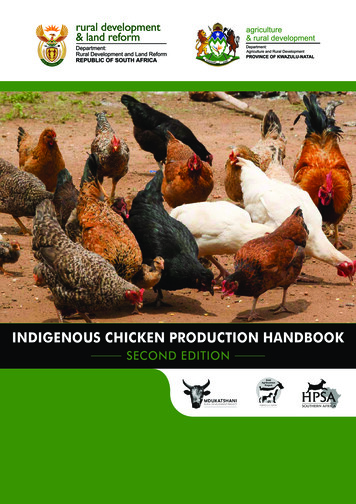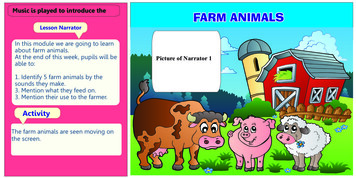
Transcription
RaisingBabyChickenshandbook
IncubationChicken incubating is egg-straordinarily spectacular!Hatching chicken eggs is an amazing process. In just 21 days,chicks pip through the shells and emerge, a bit damp andweary from their endeavour, but within just a few hours, theywill be dry, fuzzy and ready to join their hatch-mates in thebrooder.Eggs!Where can you obtain fertilized eggs for the chickenincubating process? There are three possibilities-fromyour own flock, from a friend or neighbor’s flock,or from a hatchery/mail order. The best most viablechoice, of course, is selecting eggs from your ownflock. You know your flock. And, you’ll be able tochoose the freshest eggs.The next best choice is to get eggs from someone youknow. Or, if either of these is not an option, becauseat-home chicken incubating is becoming morecommon, there are many hatcheries and mail orderoptions. Just google “hatching eggs” and voila eggs!raising baby chickens
Egg SelectionA vital component to chicken incubating is to select cleaneggs that are nicely shaped and not too round, too long, ormisshapen in any way. The shell should be void of roughnessor cracks. If you must use soiled eggs, clean them gently withfine sandpaper or sanitize them with a mixture of bleach andwater. Measure out 5 ml bleach and mix into 1L of water thatis approximately 38 degrees C. Hold eggs in the mixture for1-3 minutes, then let them air dry.You can store collected eggs, large end down, in cartons forup to six days in a cool (10-15 degrees C) dry place (not inthe refrigerator!) without harming hatchability, until you havethe number of eggs you’d like to hatch. Okay, so now youhave your precious fertilized eggs! Let the chicken incubatingbegin!raising baby chickens
Placing Eggs into the Incubator and TurningHatchability, during incubation, is directly affected by thepositioning of eggs in the incubator. Always place eggs intothe incubator with the larger end higher than the pointy end.For those of you who have the benefit of an incubator withan auto turning device then you needn’t worry about turningthe eggs. If you will be manually turning your eggs duringchicken incubating, mark your eggs with an X on one side andan O on the other side with a pencil. A good rule of thumbin chicken incubating is to turn your eggs first thing in themorning, at midday, and again at bedtime by carefully rollingthem a half turn from X to O or vice versa.Unfortunately, when opening the incubator for turning, somevery vital humidity is lost. You can make up for this loss byspraying your eggs with tepid water. Stop turning eggs on daynineteen (seventeen for bantam eggs), when chicks will beginto pip, or peck at the shell with their egg tooth-a tiny pointypart at the end of its upper beak.raising baby chickens
Candling and CullingDuring the process of chicken incubating, it’s a good ideato cull eggs that are no longer viable because they’re justnot fertile or hold already dead embryos. By removingthese eggs, you eliminate possible contamination to yourchicken incubating process from rotting eggs. Candling issimply shining a bright light behind the egg and observingthe contents. Candle eggs on day seven. Look for a networkof blood vessels encompassing a dark spot-this egg isdeveloping correctly. If you see nothing, a thin bloodylooking ring, or cloudy contents, the egg is no longer viableand should be culled.Candle again prior to stopping turning. This time look for adarkness inside the air cell (the air cell of an egg is the spacedirectly inside the eggshell which grows larger as incubationprogresses) and possible movement which indicates that allis well with the chicken incubating process.raising baby chickens
Stop Turning Eggs and PippingIt’s day nineteen, hatch day is rapidly approaching, andthis adventure of chicken incubating is getting truly eggciting! Stop turning eggs! Any minute now, pipping willbegin! Typically, pipping starts three days prior to hatchday. During stage one, the embryo is not able to accessadequate oxygen anymore, so it pips into the air cell forhelp. Stage two requires a bit more effort from the littleembryo. Oxygen from the air cell helps it to muster upenough strength to pip through the shell, pip an openingalmost all the way around, and finally, to push its new eggstraordinary chick body out! Hatching generally takes awhole day to complete the process.raising baby chickens
Cleaning Up from Chicken IncubatingAh, the little peeps have moved into their brooder and arehappily peeping and thriving in their warm cozy new digs.Chicken incubating is complete. So, it’s clean up time.ASAP following hatching, take away any eggs that failed tohatch, unplug the machine, gently clean all surfaces witha clean soft paintbrush, then wash with warm water andsoap excluding electrical parts. Let air dry, then sanitize withapple cider vinegar by mixing about 15ml ACV with waterin a spray bottle. Let air dry again, then wipe with a clothdipped in warm water. When completely dry, box it up untilyou’re ready to begin the egg-citing process of chickenincubating again!raising baby chickens
hatchingThe hatching process is hugely responsible for the biologicaldevelopment of a newborn chick, so try not to let your softside take over and break that shell open for them! It may looklike they’re struggling, but there are very powerful forces atplay during this wonderful event. See our following top tipsfor the hatching process!Don’t help them out of their eggThe act of breaking out of the hatch is crucial forstrengthening and providing the foundations for thechicks’ muscles. If you immediately scramble to crackopen their shells at the first sign of life, their physicalhealth will deteriorate quickly as their muscles havenot developed as needed.Also, it’s crucial that the chick has absorbed all theblood that’s stored in the membrane of the shell,otherwise they are at risk of serious health issues –think hemorrhaging, ruptured blood vessels, nastyproblems that will seriously impede the chicks life(and possibly shorten it). Best to limit involvement tocheering on the sidelines instead.raising baby chickens
Don’t remove the egg shellDon’t worry if it loses a toothChicks must consume the membrane found in the eggshell in order to get the nutrients they need to kick starttheir healthy lives. If you remove the shells before they areable to consume the eggs, this will do severe damage tothe chick and their immune system. Breakfast is the mostimportant meal of their first day!If your alarmed by the fact that all your newbornchicks seem to be dropping teeth like flies, don’t be –this is a very normal post-hatching mechanism. Thisis simply the egg-tooth, the little white nub that sitson the end of the chick’s beak. It’s used for initiallycracking open the shell and giving the chick its firsttaste of freedom! It will always drop off a few hoursafter birth as it is no longer has a purpose.raising baby chickens
Don’t feed the empty shells to your hensDon’t panic!It might be tempting to throw the shells in with the scrapsfor your hens to gobble up like normal, but this is definitelya sure fire way to end up in the vet surgery. The recentlyvacated shells contain a wealth of bad bacteria, and canmake your older flock extremely sick if they manage toconsume them. Dispose of the shells out of reach fromall beaks and feathers, and make sure you scrub your ownhands squeaky clean!Hatching is a complex process in which a whirlwindof wonderful, essential things need to happen to giveyour chicks the best start. Don’t start to fret if thingsaren’t moving along as fast as you’d anticipated –the process is complex and therefore can be quite alengthy one. A normal hatch takes around 24 hours,but large babies and breeds can take up to 48. Keepcalm and hatch some chickens.raising baby chickens
caring for baby chicks“Peep, peep! Cheap, cheap!” Welcome to the wonderfullyegg-citing world of fuzzy little baby chicks! Falling in love atfirst sight may be just a cliché or something that only happensin the movies, until you take your first peak at your new babychicks. When you hold their feather light fuzzy little bodies inyour hands for the first time, you feel as if you’re holding theworld in your hands, because time stands still! Nothing elseseems to matter at the moment, but the miracle of new lifepeeping away in your hands. So, go ahead, and get cluckyfor baby chicks! Sing, and shout, and do the chicken dance– celebrate the beauty and splendour that is the wonderfulworld of baby chicks!raising baby chickens
Brooder babiesThe very first step in caring for your newly hatched babychicks is to ready their brooder before they’ve hatched,you’ve picked them up, or they’ve arrived via post. Abrooder can be as simple as a large cardboard box or plastictub/container, or you can purchase a commercial chickbrooder. Most importantly, you want to be assured thateverything is in working order well before you need. So,several days prior to hatching/arrival, set up the brooder,clip on the heat lamp and plug it in. Be sure to locate theheat lamp on the side of the brooder and not directly overthe centre, so as to offer your chicks an easy egg-scape ifthey become too warm. Set a thermometer inside and aftera while, check to see that the temperature has risen to 3235 degrees Celsius. If so, turn off the lamp.One word of warning though, if you had yourchicks vaccinated against Coccidiosis, feed themunmedicated starter because the medicated starterwill cancel out the vaccine. Bedding for chicks canbe as simple as paper towel, shredded newspaper, orour favourite, hemp bedding, but whatever type youchoose, make sure to replace the bedding as often asnecessary. A clean brooder happier, healthier chicks!Then, bring on the fluffs!On the morning of hatch day, set up your brooder withbedding, feed, water, thermostat and plug in the lamp. Feedchicks a commercial chick starter, which is available asmedicated or non-medicated up until 8 weeks of age.raising baby chickens
Settling your new chicks into their brooder home mayelicit a tear or two but this is just the beginning of an eggstraordinary journey! Before you set each chick down intothe brooder, gently dip their beaks into the waterer andwatch them swallow as you place them in the brooder.Water is vital to chickens from the wee ones to the oldmother hens! They should naturally find their way to thefeeder. If not, gently scatter some chick starter onto thebedding near their feeder and that should get the ballrolling!Anyway, back to the basics. Pay close attention to howyour chicks behave. If they’re all crowded togetherdirectly under the heat source, they’re cold. Lowerthe heat lamp or add another one. If they’re aroundthe edges of the brooder, avoiding the heat and eachother like the plague, they’re too hot! Raise the heatlamp. A happy flock will happily be exploring all aroundthe brooder. You’ll easily know if the brooder is muchtoo warm or too cold!Now let’s talk about brooder basics. As mentioned above,beginning brooder temperature should be approximately35 degrees Celsius. Reduce this about 5 degrees eachweek as your young ones grow and mature. And, dothey ever! Treasure every single moment with these littleones, because in the mere blink of an eye, fuzzy becomesfeathery and soon they’ll be anxious to fly from themotherly brooder to the coop and egg-splore the greatoutdoors!raising baby chickens
Simply watching the everyday goings on inside the brooder,is GREAT FUN and will keep you abreast of your babies’comfort level. So, what does a typical chick look like andhow does it behave? For the first day or two, baby chicksare much like human newborns – they sleep, eat, and peepand poop! Sleepy chicks are often quite hilarious as theycan fall asleep in the blink of an eye, literally-they just flopdown wherever they are and they’re asleep. They can evenfall asleep, wait for it standing up, although they do look abit a wobbly! You may even spy a bit of feather popping outhere and there, depending on the breed, as some breedsdo mature more quickly than others. Hold on to your hatthough, because these quiet sleepy days are over!Growing chicks are busy, busy, busy! They are eggstraordinary multi-taskers! They can peep, poop, flap, andrun all at the same time! Simply amazing, isn’t it? Thesecurious babies want to egg-splore, egg-splore, egg-splore!raising baby chickens
Chirpy and healthy chicksWell, now that we know what a typical healthy chicklooks like and how it behaves, what are some signs andsymptoms that we should be on the lookout for in a not sohealthy baby chick? Since healthy chicks are busy chicks,chicks that are feeling under the weather will most likelynot be busy. Signs of an ill chick are inactivity, watery eyes,watery poop (more than usual) and not eating or drinking.Chickens’ respiratory systems are quite sensitive; therefore itis essential to keep their brooder as clean as possible. Soiledbedding is a breeding ground for illness, as chicks tend topeck at their own poop.A common malady that effects young chicks is called“pasting up”. Pasting up occurs when a chick’s droppingsstick to it’s fuzzy little chick vent. If you notice this, simplyapply a moist warm cloth or paper towel to the chick’sbottom and wipe gently. If left untreated, it can causemore serious complications as the poor baby cannot passdroppings. So, keep a watchful eye on your flock and theyshould develop normally and grow like crazy!raising baby chickens
Making friendsGently handling your chicks will help them to getaccustomed to human touch. Some will be more apt tointeract with you than others, and that’s perfectly normal.Encourage the shy ones with feed from your hand, or offerthem treats such as mealworms, cracked corn or greens.Chickens are very, very, very motivated by food! So, bepatient and they’re sure to come around. An egg-cellentway to encourage socialization is to host a family sleepoverwith the chicks! If your brooder is set up in a spare room,wonderful, camp out right there. However, if not, just movethe brooder temporarily to the family room, sunroom, orplayroom and let the FUN begin!If you’re not afraid of a little poop, then let them outof the brooder to wander around and get their “cooplegs” so to speak, and they will inevitably climb all overyou and your family! The point is to savor these firstfew days and weeks with your fuzzy chicks, becausethey practically “fly” by.Hold your chicks, brainstorm names for the new featheryfamily members, quietly whistle to them they’ll literallystop whatever they’re doing, yes they’ll even cease peepingto listen, read chicken keeping books and quiz each other,cuddle with your chicks, make up chicken riddles, talk toyour chicks, do a chicken find-a-word, sing to your chicksand mostly just love those sweet little baby chicks!raising baby chickens
Roost-a-rama!At three weeks old your young flock is ready for, waitfor it roosting practice! Yay! This is just such fun towatch! You can easily make a homemade roost bydrilling a hole in two wooden blocks and inserting adowel between so that the roost is approximately 5cmoff the brooder floor. It’s time for roosting practice!Your chicks will be cautious at first, yet intrigued bythis newfangled piece of furniture that just appearedout of nowhere inside their cozy abode. They will peckat it egg-cessively, but eventually, curiosity will getthe better of them and they’ll hop on up. Be preparedthough, because chances are these young trainees willtopple over peeping all the way. You can help themto get back on again by gently setting them above themini-roost until their little feet grip. When your chicksoutgrow this roost, you can replace it with a higherone. Here’s to happy training sessions!raising baby chickens
Out and about!Next, on your young flock’s agenda, are field trips to theyard. These first outings are such fun. On a lovely warmsunny day, transport the brooder outside for a little tasteof egg-straordinary adventures yet to come! Let them outinto the fresh grass and sit back and watch your egg-staticlittle ones leap and flap, peep and poop, run and chase andjust have the grandest time living as nature intended. Theycan run fast! So be sure to stay close, or put them in an areawhere they can’t escape through a fence. When they’ve hadenough of the good life take your eggs-hausted little onesback inside for some much needed naps.So, your fuzzy little babies are literally growing by leapsand bounds! Wonderful! It is absolutely egg-straordinaryhow quickly these young ones do grow. Ah, but alas, thesesweet babies are now maturing young pullets, feathershave replaced most of the fluff, they’ve grown quite tall andgawky, and they’re well on their way to becoming lovelyyoung hens. Growth and development zip along at a fastpace from day two or three on up to about three monthsof age as your chicks undergo their biggest transformationfrom baby to young chook.raising baby chickens
It’s always enjoyable to be able to look back on our pastchick eggs-periences and reminisce about the journey youhad with your family as you watched the chicks grow! Asyour young chooks continue to grow and mature sometelltale signs that they are doing so will be the changesin their combs and wattles- these will grow larger andbecome a brighter red color. Young roosters-to-be mayeven begin to crow about their egg-speriences at around12-16 weeks of age!Eventually, it will be moving day! At about 6 – 8 weeks ofage, your fully feathered friends will be ready to move totheir outdoor coop and let nature continue the course youso lovingly began. So, what began just a couple of shortmonths ago, will always continue in your heart! Have aneggs-traordinarily flap-happy journey!raising baby chickens
Need to know more about raising baby chickens?Have a little peck at our Learning Centre!raising baby chickens
raising baby chickens Chicken incubating is egg-straordinarily spectacular! Hatching chicken eggs is an amazing process. In just 21 days, chicks pip through the shells and emerge, a bit damp and weary from their endeavour, but within just a few hours, they will be dry, fuzzy and ready t
